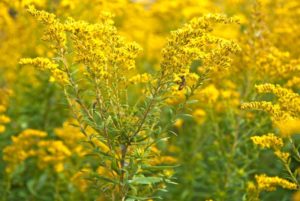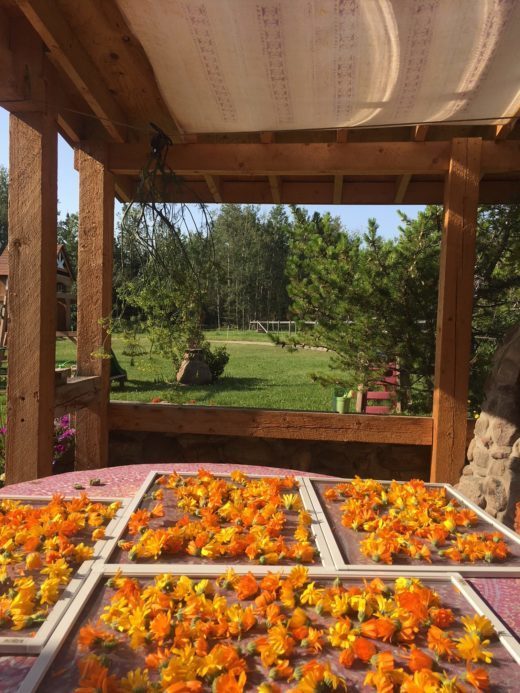
The Magic of Mother Earth
 The abundance and beauty of the Earth at this time of the year in the Peace Country is amazing. I encourage you to bring some of the magic of Mother Earth into your home by adding the wild greens to your food, preparing a cup of tea with fresh plants or harvesting and drying herbs for later use. Goldenrod is one of those amazing herbs you can see everywhere right now.
The abundance and beauty of the Earth at this time of the year in the Peace Country is amazing. I encourage you to bring some of the magic of Mother Earth into your home by adding the wild greens to your food, preparing a cup of tea with fresh plants or harvesting and drying herbs for later use. Goldenrod is one of those amazing herbs you can see everywhere right now.
Goldenrod is a fairly tall plant with beautiful, vibrant golden-yellow flowers. You will find it in dry woodlands, forest clearings and roadsides.
The Latin name Solidago originates from “solidus” & “ago,” Solidus, meaning “healthy and strong,” and ago meaning “to make whole.” Both of these terms refer to the plant’s ability to heal wounds.
Some common names for Goldenrod from various cultures also give an indication for its medicinal use as a wound healing herb, for example in Germany the herb is often called “Fastening Herb”. In fact in ancient German history Goldenrod was gathered as a wound herb before engaging in battle, just in case it was needed.
However, the focus today for its use has shifted from a wound healing aid, to a very reliable herb to support the kidneys. It promotes the elimination of urine and is applied for acute as well as chronic conditions of the kidneys and bladder including inflammation. In addition, it has been found to support the body during times of upper respiratory infections, especially when dealing with a chronic situation.
For medicinal purposes the leaves and flowers (early flowering stage) are being harvested and may be used fresh or dried. The fresh leaves and flowers can be used for wound healing or made into a tea, which can also be used as a wound wash. The dried herb may be used in the form of a tea as well but also as a tincture. A tincture is an alcoholic extract of a plant and is more concentrated than an herbal tea. The “crafty” person might want to try to use the flowers as a natural dye.
This summer Goldenrod has been brightening up the landscape in so many places and the quality of it has been superb. Many times you will find it being “infested” with many small bugs, but this year the only insects I have watched enjoying the bright, yellow flowers are butterflies and bees!
If you are not sure how to prepare the herbs, remember that the DVD Herbal Pharmacy for Everyone provides clear and easy to follow instructions, teaching a great variety of herbal preparations. Check my website www.herbalinstructions.com for more information.
Disclaimer
This information is not intended for the use of diagnosing any disease, condition or prescribing any treatment whatsoever. The use of any of the herbs and preparations is the sole responsibility of each individual and does not replace the services and advice of a medical practitioner and qualified healthcare provider. Consult a qualified healthcare professional before making medical decisions or if you have questions about your individual medical situation. No responsibility is assumed should the information be used in place of a licensed medical practitioner’s services.
“NATURE’S MEDICINES”
The perks of summer: bountiful harvest of nature’s medicines! I already made my first batch of the ointment, my clients call the “miracle magic cream”.
Remember that spending time in nature has many health benefits, many of which are being proven scientifically now. More on this one another day.
REMEMBER the post on PLANTAIN and its use as a spit poultice for insect bites. Sometimes Plantain is not around but you can use another plant that is abundant at this time of the year – the leaves of FIREWEED can also be chewed and applied to insect bites including wasp and hornet stings.
Green blessings,
Gudrun

WEEDS FOR WELLNESS – A GUIDE TO YOUR BACKYARD PHARMACY
CHICKWEED – Stellaris media
 Chickweed is one of my favorite herbs. You can use all aerial parts of the plant. My husband has gotten into trouble more than once when he got rid of it from garden beds. Chickens and small birds enjoy feeding on Chickweed as well – probably the reason for its name. Chickweed is very nourishing, it contains many minerals and vitamins such as vitamin C, copper, iron, phosphorus and potassium.
Chickweed is one of my favorite herbs. You can use all aerial parts of the plant. My husband has gotten into trouble more than once when he got rid of it from garden beds. Chickens and small birds enjoy feeding on Chickweed as well – probably the reason for its name. Chickweed is very nourishing, it contains many minerals and vitamins such as vitamin C, copper, iron, phosphorus and potassium.
My preference is to use Chickweed raw in salads, added to smoothies and the Jungle Juice, and as a garnish on sandwiches and in wraps. The flavour is mild and as with many herbs the younger plants are preferable. Especially when using it raw for salads and toppings, the stems of more mature plants get stringy, so you may only want to us the (flowering) tops. Try mixing it into cream cheese or make a herbal butter by adding chives and chickweed and maybe a bit of flax oil.
You can also add Chickweed to soups and other cooked dishes. However, you don’t want to cook Chickweed for more than a few minutes; therefore I suggest you add it towards the end after any other vegetables and greens have their required tenderness.
Medicinally Chickweed is very soothing to the skin. I like to use it externally for skin conditions such as eczema and itchy skin. It also has a cooling effect. Apparently the herb is also used as a tea in natural weight loss programs; however, I do not have any personal experience with this application. Less well known is the fact that Chickweed helps to soothe stomach ulcers and other digestive ailments.
Have fun, be creative and I hope you will enjoy Chickweed as much as I do.
Green blessings,
Gudrun



Follow Us!